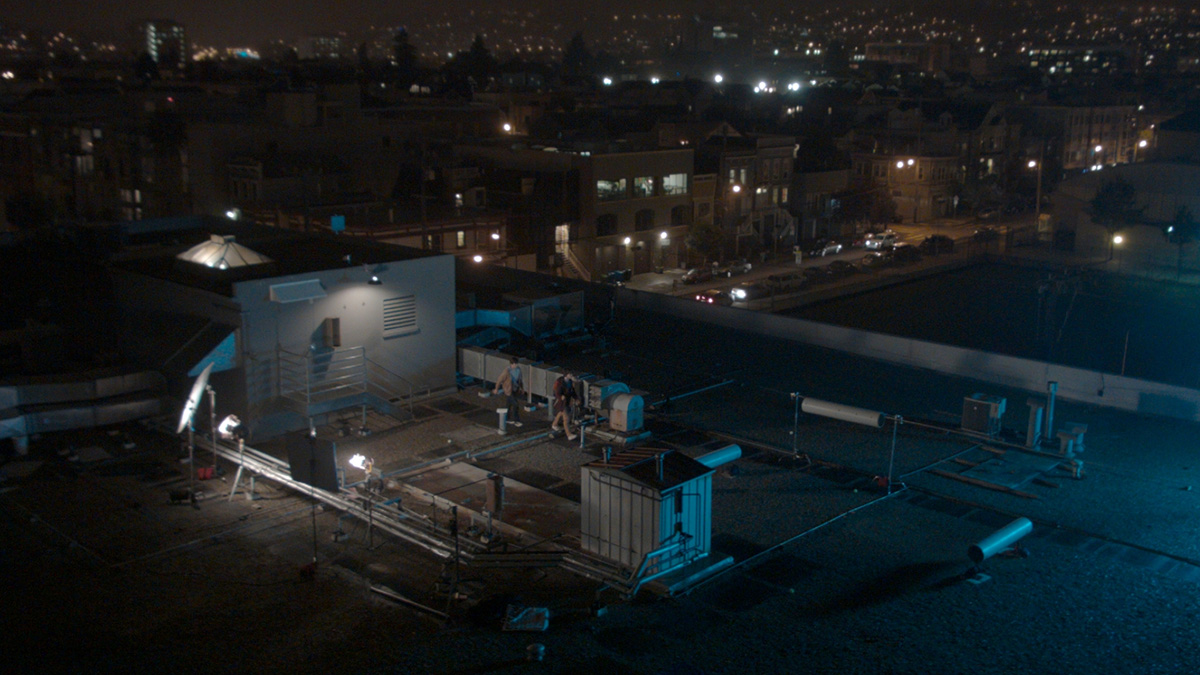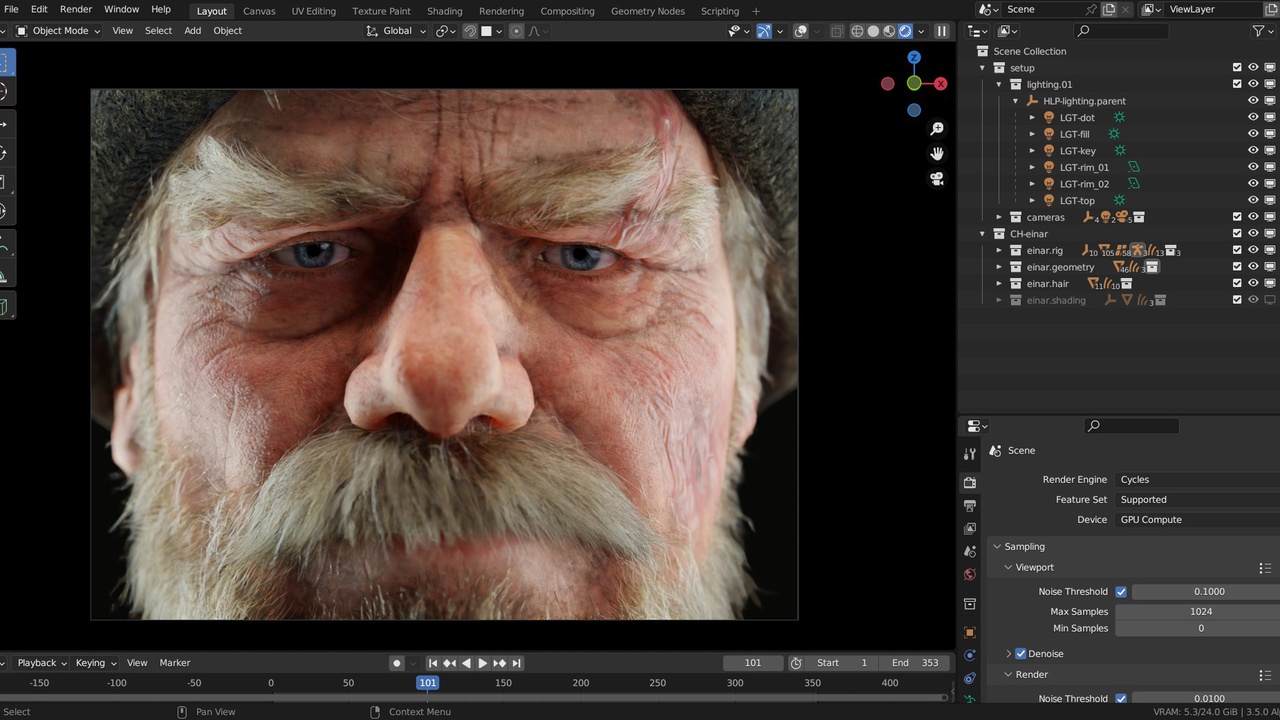Go behind the scenes of the made-with-Blender short, ‘Skywatch’.
Ex-Pixar artist Colin Levy began scoping out plans to make his live-action sci-fi short Skywatch – about the chance discovery of a weaponized delivery drone – way back in 2012.
He shot it in 2014 and then faced the tough task of adding visual effects. This was aided by a successful Kickstarter in 2017. Now, finally, the film has been unleashed to the world.
To get there, Levy enlisted visual effects supervisor Sandro Blattner and tapped into the vibrant Blender community to help produce a raft of CG and VFX shots. befores & afters asked Levy and Blattner about the post-production process and sticking with something that took so long to make.
b&a: Had you already started shooting before the Kickstarter?
Colin Levy (director): That Kickstarter from 2017 was just for post-production. So we were well underway with the rest of the project. In fact, we shot it three years prior to that Kickstarter. When we launched that campaign, we had pretty much a locked cut aside from a couple of small pieces. Principal photography was in 2014. I took a leave of absence from Pixar for three months – that’s when we shot the bulk of the film.
Over the course of the following year, I was editing in my nights and weekends. It became clear that we bit off a whole lot more than we could chew. We had so many visual effects shots that we decided we could use some additional help. And the Kickstarter was a part of that effort.

b&a: Obviously the Kickstarter was successful. What did that allow you to do in terms of VFX and post?
Sandro Blattner (visual effects supervisor): The Kickstarter had a portion that we set aside for the commercial shoot, which is at the top of the film. So there was a small production component. But as far as the VFX was concerned, we basically decided that, in the grand scheme of things, it wasn’t really a lot of money. It wasn’t a lot of money in terms of just the workload. So we decided to use it for roto and tracking, primarily. These are things that are harder to find volunteers for.
Colin Levy: We also had some questions about, what was the balance going to be like between freelancers, boutique studios and volunteers. Initially we were planning on working with a single visual effects company for a significant portion of the workload. Over time that plan evolved based on how that was going, but also realizing just how much work there was. There’s no way that we could possibly have afforded to farm it out in this way and expect the standard of quality that we’d set for ourselves. So, it ended up being that Sandro and I did quite a lot of shot work together. We would go out to volunteers or specialists for specific tasks.
b&a: What drove you to choose Blender in making the short?
Colin Levy: I’ve been using Blender for over half my life. I attribute that piece of software, to be honest, to my whole career trajectory. It’s definitely a tool that I know like the back of my hand and that comfort level had a lot to do with this decision. It’s also just got this phenomenal community. Knowing what I know about the Blender community, and relationships I’ve built over time having been a part of seeing Blender projects, it was partially a strategic decision in that regard.
I knew there would be a pool of talent that I might be able to get excited to work together with me. Indeed, one of our greatest collaborators was Paweł Somogyi, who’s a Polish Blender generalist. He is someone I didn’t know prior to this project but got connected to him through the community. For years he’s put in a whole ton of work and has just done phenomenal work on this film, for nothing. I’m so grateful to him and others who’ve contributed.




On a technical level, it might be a surprise to others still at this point, but having worked with it for such a long time, there’s not that much that Blender can’t do. There wasn’t anything that we were scratching our head about, like, ‘Can Blender handle this?’
There were a couple of specific visual effects requirements for a shot here and there where we did use, say, a Houdini simulation. And then Sandro is a NUKE whiz, and so all the Blender stuff is just a starting point – quite a lot was actually handled in Nuke. But in terms of the core CG assets and character animation, all that was done in Blender and I knew that the tool was definitely ready for the job.
Here’s how you can learn VFX in a real studio production environment
Sandro Blattner: The community made a big difference because there’s a lot of enthusiasm and excitement there to work on something that’s as ambitious as this. So I think we both found it fairly easy to get really talented, really skilled people, excited to help out with this. I feel like if we had a traditional sort of Maya workflow, it would’ve been a bit more difficult to find that enthusiasm to volunteer.

b&a: Tell me a little bit about how that worked in terms of people working remotely and how you actually co-ordinated it?
Sandro Blattner: It was kind of a ‘process’ for us to figure that out along the way. We tried different ways of managing files and managing tasks. For a good stretch of the process, we used an open source online platform called Producteev, which doesn’t exist anymore, I think. It was a basically a simple task tracker, your poor-man’s Shotgun, I guess.
For exchanging files and getting people kicked off, all of that stuff was very manual. We had a Dropbox and a Google Drive, and it was a matter of getting all the files ready and putting them up there and then sending emails back and forth and hopping on Skype with people. I think that’s all something that can be easily underestimated in terms of how much time you take just to kick people off and manage and supervise. We did have about 50 people in total at the end of the day that helped out in post.
b&a: What would have been one of the tougher shots to pull off in the short?
Sandro Blattner: The opening commercial that we shot, from a compositing standpoint, was tricky because there was a lot of clean-up work that needed to be done for it. On the CG side, we had to build part of the rooftop as a full CG environment and Colin actually did a lot of that.
Colin Levy: Well, an early cut of the film just wasn’t working super well. We got some notes and decided it was worth going back and re-shooting certain sections and basically doing some pick-ups. We cut a scene and the challenge became taking a part of the scene apart and putting it back together with pieces that we could easily get.


The challenge, at that time, was that we couldn’t get the location again. We couldn’t get back up on the roof. Our actors were local to LA anyway, and that would be a big expense to fly them back out to San Francisco where that shoot was. So we decided to shoot some of these pick-up shots on a greenscreen stage, but they had to match the sequence that already existed.
Fortunately I was able to get up on that rooftop once more just to shoot some reference photography. I used that material to essentially reconstruct portions of the rooftop in CG with mostly camera projection-based environment reconstruction. I’d add some CG tubes and scatter pebbles and grass to add in more details.
Sandro Blattner: The assets we had to develop for the film – the portal and the drone – went through an extensive design process. Early on it was pretty much an industrial design challenge to figure out what these assets looked like come up with something that felt believable, i.e., in the realm of near future technology. The transformation animation for the drone was heavily planned, too.
Colin Levy: Yes, this whole whole film hinges on the reveal of this weaponized interior of the drone. It’s pretty darkly lit in the actual moment, but if you look up close it at this transformation, it looks really good.



b&a: It’s been a long road to getting the film finished, how do you feel about it right now?
Colin Levy: I’ve never worked on something as long as I’ve worked on Skywatch. I don’t think any of us had any idea it was going to take this long. It’s definitely been a long road for me, in particular, since I started like brainstorming ideas back in 2012! I’m just really excited to finally be at the stage where we can share the fruits of our labor.
This is all kind of in service of a grander dream to make a feature film. So, it’s the proof of concept for a feature that I’ve also been writing. I’m optimistic that there might be some promising conversations around another iteration of this thing. I’m very relieved to be at this stage and to actually be in a place where maybe I can move on with my life.

Sandro Blattner: It was years of having this pile of work ahead of us and it would seem never-ending at times. To be at this point now and being able to release it and feeling good about it, it feels good all around, really.
Colin Levy: There have been so many people who have helped make this thing a reality. And Sandro is number one on that list. No one has put more time in than Sandro has. So I’m just feeling very grateful to him, but also to our incredible team. It’s really been such an honor and privilege to get to work with these talented folks.
Head to https://skywatch-movie.com for more on the film.


















Great article. Colin and Sandro (and a slew of volunteers) made the film what it was…with an incredible amount of hard work, passion, and perseverance! 🙂